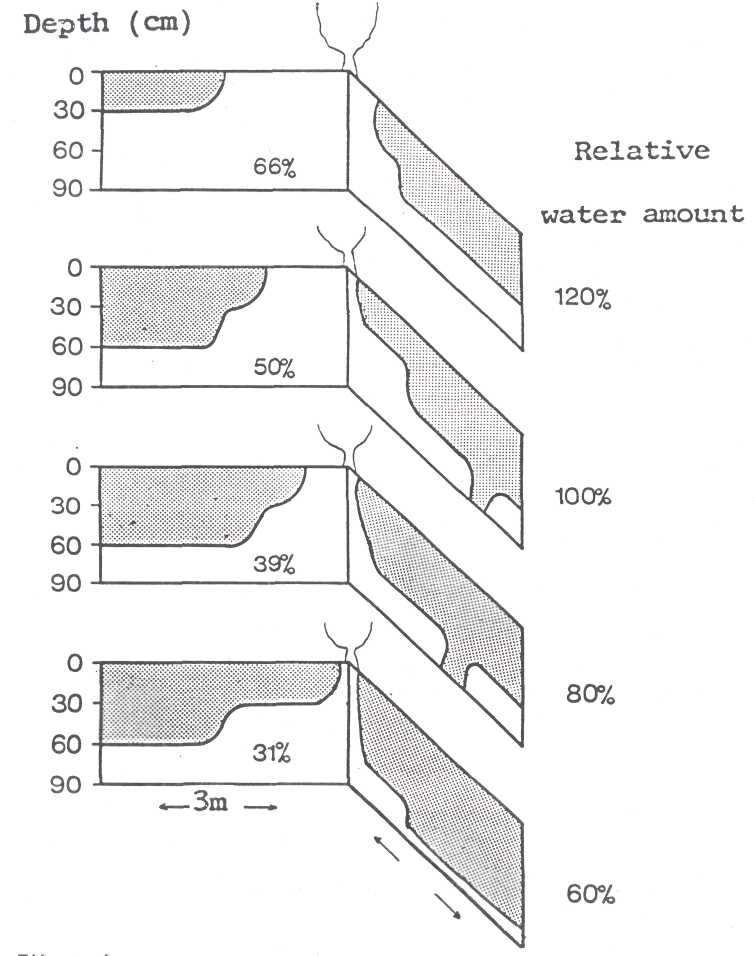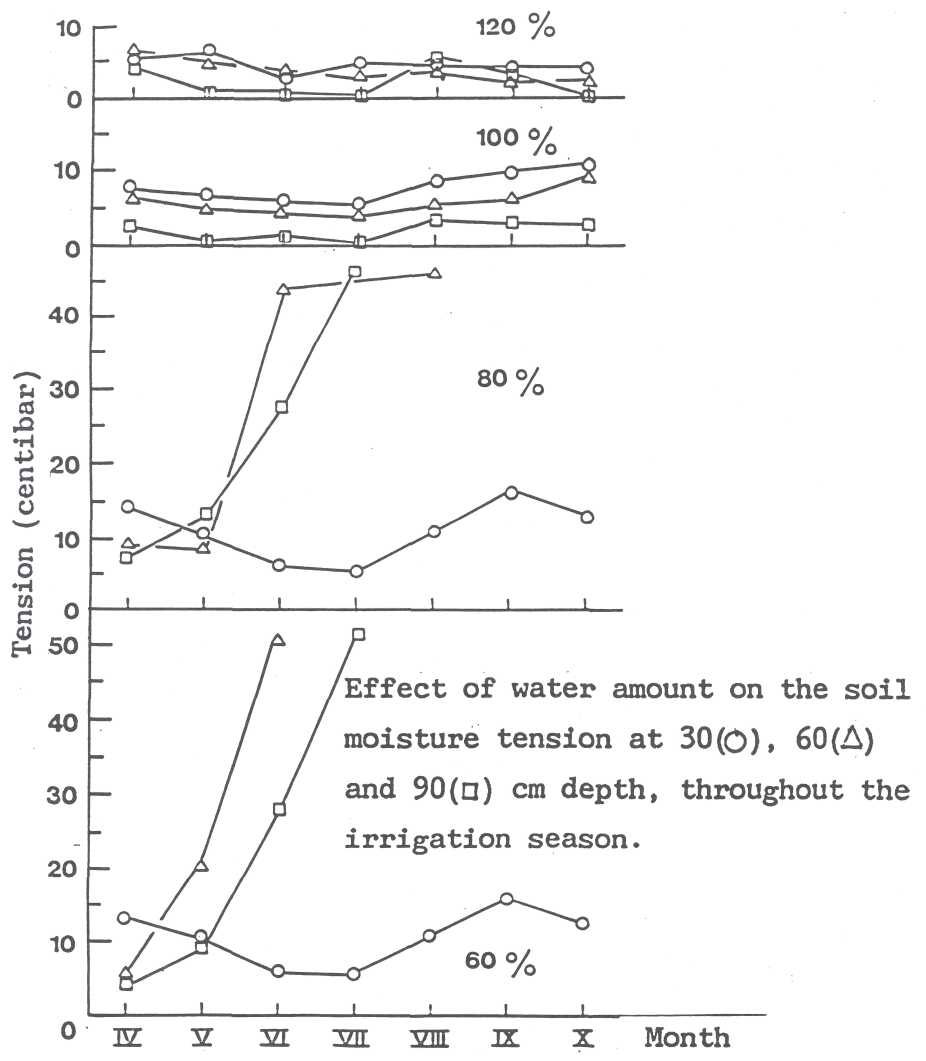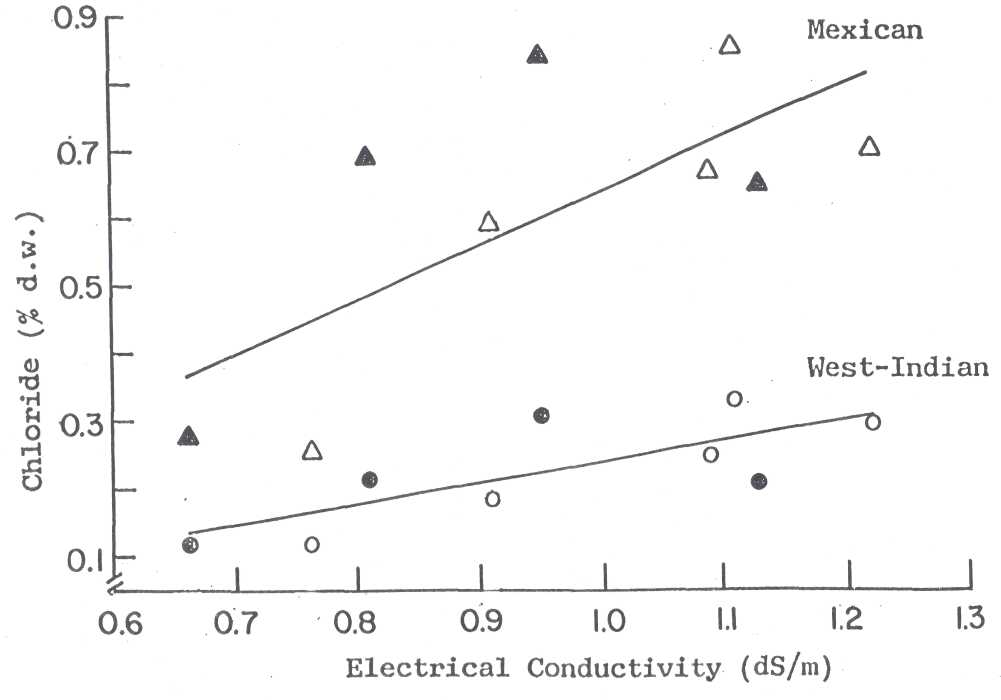Proc. of Second World Avocado Congress 1992 pp.
323-330
Water Requirements and the Effect of Salinity in an Avocado Orchard on Clay Soil
Emanuel
Lahav and Reuven Steinhardt
Agricultural
Research Organization, The Volcani Center, Bet Dagan, Israel
Dov
Kalmar
Regional
Experiment Station, Akko, Israel
Abstract. An experimental plot was planted to study the effect of drip irrigation on the development and bearing capacity of avocado trees. The following four water rations were applied: the commonly applied amount of water (100%), determined according to tensiometer readings and neutron probe (this ration was applied to the upper soil layer (0-60 cm) when the tension did not exceed 20 centibars); and three rations which amounted to 60%, 80% and 120% of the above. The amounts of water actually applied ranged from 2830 to 5720 mP/ha, which are markedly less than those applied in commercial orchards.
The irrigation regimes had a marked effect on tree growth. The more water was applied, the larger the trunk circumference grew. Trees of 'Fuerte' were affected more than those of 'Hass'.
Irrigation treatments had a significant effect on yield. In both cuitivars a 17% reduction in the amount of water applied resulted in a 20% reduction in the number of fruit per tree and in individual fruit size. A 50% reduction in the amount of water applied reduced yield by 33%. A second experiment under the same conditions (using microjets instead of drippers for irrigation) showed that an increase in salinity from 90 to 380 mg CI/L reduced 'Ettinger' and 'Hass' yield by 25%. A significant reduction in the damage can be achieved by proper selection of rootstocks, leaching, and nitrogenous fertilization.
In an irrigation experiment conducted in western Galilee, it was found possible to irrigate avocado plantations at wide intervals (up to 21 days) and with reduced water amounts of 6700 m3/ha/yr per year (in addition to 6000 m3/ha/yr of rain), without impairing the fruit yield or quality (Lahav and Kalmar, 1977). A second experiment showed that an additional reduction in the amount of water applied was not possible and that water distribution during the irrigation season should be changed (Lahav and Kalmar, 1983).
These experiments were conducted with an under-the-canopy sprinkling system. With the introduction of microjets and drippers to avocado plantations a further reduction in water amounts was possible. These irrigation methods have also other economic advantages, such as reduced weed control and reduced spread of root rot. The drip method, more so than other irrigation methods, supplies the tree not only with the water it needs, but also with nutrients in precise amounts.
The avocado tree is well known for its sensitivity to soil aeration. This problem is severe mainly in the heavy clay soils of western Galilee. Therefore the drip method, accompanied by water reduction, has a good chance to improve soil aeration and to increase the efficiency of water use in the avocado.
With the reduced amounts of water available for irrigation of avocado trees in Israel, the salinity of the water is increasing. Since the avocado is one of the crops most sensitive to salinity, a second experiment was established in order to determine: (i) the reaction of the various avocado rootstocks used in Israel to different levels of salinity in the irrigation water, (ii) the degree of damage caused by salinity, and (iii) potential agrotechnical procedures to reduce this damage.
Materials and Methods
Experiment 1. Irrigation
An experimental plot on a low-lime grumusol with 60% clay was planted in 1977 to study the effect of different amounts of water supplied by a drip irrigation system on the development and bearing capacity of avocado trees. Each tree was supplied with 12 drippers, discharging 4 L/h each.
Four water rations were applied: the standard water amount determined according to tensiometer readings (100%), and three other rations amounting to 60%, 80% and 120% of the above. The average annual water amounts in the four treatments were 2890, 3930, 4750 and 5720 m3/ha, respectively, in addition to 6000 m3/ha of precipitation. These amounts ranged from significant deficiency to an ample amount of water.
The experiment comprised six replications of 12 'Fuerte' and 12 'Hass' trees in each plot.
Nitrogen was injected at a constant concentration of 40 mg/L as liquid NH4NO3 into the drip irrigation system; thus, the N quantity varied according to the amount of water applied. Due to a technical failure, no N was applied to the 100% plots during the 1982 and 1983 irrigation seasons. In the summer of 1984, the regular N fertilization regime was resumed (Table 1).
The effect of N deficiency on yield, fruit size, leaf composition and sensitivity to frost has already been reported (Lahav et al., 1987, 1990).
Experiment 2. Salinity
The plantation was planted in 1984 with 'Ettinger' and 'Hass' trees. This trial is still in progress and the results presented herein are preliminary. The trees were grafted on either Mexican (sensitive to salinity) or West Indian (resistant to salinity), rootstocks.
The two main treatments were irrigation at two levels: at 85% of the recommended amount of water and at 115% of the recommended amount of water. Four levels of salinity were tested: 90, 250, 380 mg/L of Cl- and an adjustable amount between 250 and 380 mg/L of Cl- in the irrigation water. In addition, one treatment included an increased level of nitrogen in the irrigation water. All treatments were given continuous nitrogen fertilization at a rate of 250 mL Super-737/L of irrigation water.
Results
Experiment 1. Irrigation
With the increase in water ration, the wetted soil volume increased (Fig. 1) and the water tension in the lower soil layers decreased (Fig. 2); more roots were found therefore in these layers.
The irrigation regimes had a marked effect on tree growth. The more water that was applied, the larger the trunk circumference grew (Table 2). Since the 'Hass' trees were younger than the 'Fuerte', they were affected more strongly by the amounts of water applied.
'Hass' trees came into production in 1981/82 and 'Fuerte' a year later. Starting in 1982/83 the average yield of both cultivars was significantly affected by the water regime (Table 3). A 20% reduction in the amount of water supplied reduced the number of fruits per tree by 18%. The decrease in the amount of water applied in the 120% treatment (5720 m3/ha) compared to the 60% treatment (2890 m3/ha) reduced the yield by 34%. In addition to the effect on the number of fruit, water affected individual fruit size, which increased as more water was applied.
Experiment 2. Salinity.
The preliminary results of this trial indicate that increased salinity was followed by increased chloride levels in the leaves (Fig. 3). The concentrations in the leaves of the trees grafted on Mexican rootstocks were three times as high as in those grafted on West Indian rootstocks. Also affected was tree growth expressed as trunk cross section area (Fig. 4): the higher the Cl- level, the less the growth. The effect of leaching was significant and tree growth under the surplus water regime was higher than that of the regular water regime for all levels of salinity.
There was a very clear effect of salinity on the average yield of the two cultivars (Table 5): the higher the salt concentration, the lower the yield. The highest yield was always obtained in the trees irrigated with a surplus amount of good quality water. On the average, the 120% treatment increased the yield by 16 to 27%. The additional N applied brought the yield to the level obtained by the surplus amount of water (Table 4).
Discussion
The results obtained in the irrigation experiment were influenced both by the amount of water and nitrogen applied. It is impossible to separate these two factors. However, it is probable that most of the effect was due to the water, since even the small amount of N applied (approximately 108 kg N/ha in the 60% treatment) is applied in many commercial avocado plantations.
A reduction in water amount decreased tree growth by decreasing the number of growth cycles during the irrigation season, leading, probably, to a smaller canopy and thus a smaller bearing area of the tree. Reduced water and N enhanced the tree's sensitivity to frost, as already reported (Lahav et al., 1987). This effect was due to both the reduced size and general weakening of the tree.
The highest irrigation amount was accompanied by the highest yield. Every reduction in water allocation was followed by a significant reduction in yield. A reduction of 1000 m3/ha in water reduced the 'Hass' yield by 2.2 t/ha and the 'Fuerte' by 1.6 t/ha. This is equivalent to approximately 20% of the total crop. These figures are further increased by the reduction in fruit size. The latter is significant mainly in cv. Hass, which suffers from small fruit, sometimes below export quality.
It should be emphasized that the experimental conditions were ideal for saving water: (i) drip irrigation, which reduced the wetted soil volume; (ii) clay soil, which is capable of storing large amounts of water; (iii) an average rainfall of 600 mm; and (iv) good quality water, which eliminates the need for leaching.
The results of the salinity experiment proved the
basic assumption that salinity impairs the growth and production of avocado
trees even if grafted on West Indian rootstocks. The initial results indicated
that optimal growth conditions with respect to irrigation regime and N
fertilization might reduce or even prevent the damage. Increasing N application
to prevent Cl- uptake should be explored further. The inferiority in
salt tolerance of the Mexican rootstock as compared with the West Indian rootstock
was also confirmed. Salinity (380 mg/L Cl-) reduced the average
production of 'Ettinger' and 'Hass' trees by 46% when grafted on a Mexican
rootstock, but by only 24% when grafted on a West Indian.
Contribution from the Agricultural Research
Organization, The Volcani Center, Bet Dagan, Israel. No. 3352-E, 1991 Series.
Literature
Cited
Lahav, E. and D. Kalmar. 1977. Water requirements of avocado in Israel, (b) Influence on yield, fruit growth and oil content. Austral. J. Agric. Res. 28:867-878.
Lahav, E. and D. Kalmar. 1983. Determination of the irrigation regimen for an avocado plantation in spring and autumn. Austral. J. Agric. Res. 34:717-724.
Lahav, E., Y. Bar, and D. Kalmar. 1990. Effect of nitrogenous fertilization on the annual variations in nutrients in avocado leaves. Comm. Soil. Sci. PI. Anal. 21:1353-1365.
Lahav, E., D. Kalmar, and Y. Bar. 1987. Nitrogen fertilization, a guarantee for relative resistance of avocado trees to frost. J. PI. Nutr. 10:2859-2868.
|
Table 1: Nitrogen
quantities applied in the experiment plots. |
||||
|
Year |
Relative water amount (%) |
|||
|
60 |
80 |
100 |
120 |
|
|
Kg /ha |
||||
|
1978 |
29 |
42 |
49 |
60 |
|
1979 |
45 |
61 |
66 |
78 |
|
1980 |
49 |
61 |
70 |
86 |
|
1981 |
98 |
132 |
161 |
190 |
|
1982 |
122 |
158 |
- |
248 |
|
1983 |
125 |
165 |
- |
254 |
|
1984 |
88 |
131 |
157 |
189 |
|
1985 |
120 |
164 |
197 |
209 |
|
1986 |
94 |
126 |
156 |
186 |
|
Table 2. Effect of irrigation regime on trunk circumference. |
|||||||
|
|
|
Relative water amount (%) |
|
|
|||
|
Cv. |
Year |
60 |
80 |
100 |
120 |
S.E. |
Significancez |
|
cm |
|||||||
|
Fuerte |
1977
|
27.0 25.1 c |
36.5 29.7 b |
26.9 31.0b |
28.0 31.0 b |
0.76 0.79 |
N.S. * * * |
|
|
|
|
|
|
|
|
|
|
Hass |
1977 7 yr Increase |
16.3 b 38.8 c |
17.1 ab 45.1 b |
17.7 a 47.6 b |
17.9 52.8 a |
0.37 1.02 |
* * * |
|
z * = (P<0.05), ** = (P<0.01). |
|||||||
|
Table 3. Effect of
irrigation regime on the average yield of cvs. Hass and Fuerte. |
||||||
|
|
Relative water amount (%) |
|
|
|||
|
Year |
60 |
80 |
100 |
120 |
S.E. |
Significancez |
|
Number of fruit per tree |
||||||
|
1978/79 |
20 |
17 |
28 |
25 |
3.1 |
N.S. |
|
1979/80 |
7 b |
10 ab |
8 ab |
13 a |
1.6 |
* |
|
1980/81 |
13 b |
27 ab |
47 a |
26 ab |
6.6 |
* |
|
1981/82 |
85 |
87 |
86 |
93 |
7.1 |
N.S. |
|
1982/83 |
236 c |
312 b |
343 b |
393 a |
15.3 |
** |
|
1983/84 |
159 |
158 |
72 |
182 |
15.3 |
N.S. |
|
1984/85 |
262 b |
304 b |
201 |
460 a |
20.1 |
** |
|
1985/86 |
58 |
52 |
49 |
56 |
8.7 |
N.S. |
|
1986/87 |
291 b |
314 b |
304 b |
399 a |
27.8 |
* |
|
Averages |
|
|
|
|
|
|
|
1978 to 1986 |
125 b |
142 b |
127 |
183 a |
7.3 |
** |
|
1982 to 1986 |
201 b |
228 |
194 |
298 a |
10.6 |
** |
|
1982 + 1986 |
263 c |
313 be |
324b |
396 a |
17.6 |
** |
|
z * = (P<0.05), ** = (P<0.01). |
||||||
|
Table 4. Effects of salinity, irrigation regime and rootstock on the average yields of cv. Ettinger (5 years) and cv. Hass (4 years). |
||||||
|
Rootstock |
Irrigation Regime |
Chloride concentration (mg/L) |
Avg. |
|||
|
90 |
250 |
250 + 380 |
380 |
|||
|
kg/tree |
||||||
|
Mexican |
Regular |
14.4 |
9.9 |
9.4 |
7.8 |
10.4 |
|
|
Surplus |
16.8 |
13.3 |
9.3 |
9.0 |
12.1 |
|
|
+ N (40 mg/L) |
13.8 |
|
|
|
|
|
|
Avg. |
15.6 |
11.6 |
9.4 |
8.4 |
11.2 |
|
West Indian |
Regular |
21.2 |
16.6 |
17.6 |
17.7 |
18.3 |
|
|
Surplus |
27.8 |
22.2 |
23.6 |
19.8 |
23.3 |
|
|
+ N (40 mg/L) |
|
21.1 |
|
|
|
|
|
Avg. |
24.5 |
19.4 |
20.6 |
18.7 |
20.8 |

Fig 1. Effect of water amount on the wetted soil volume (%).

Fig 2. Effect of relative water amount on the soil moisture tension at 30 (O), 60 (triangle) and 90 (square) cm depth, throughout the irrigation season.

Fig 3. Effects of salinity, rootstock and water amount (empty symbols surplus supply) on chloride concentration in the leaves.

Fig 4. Effect of salinity and water amounts on trunk cross-section area (cm2 /tree).